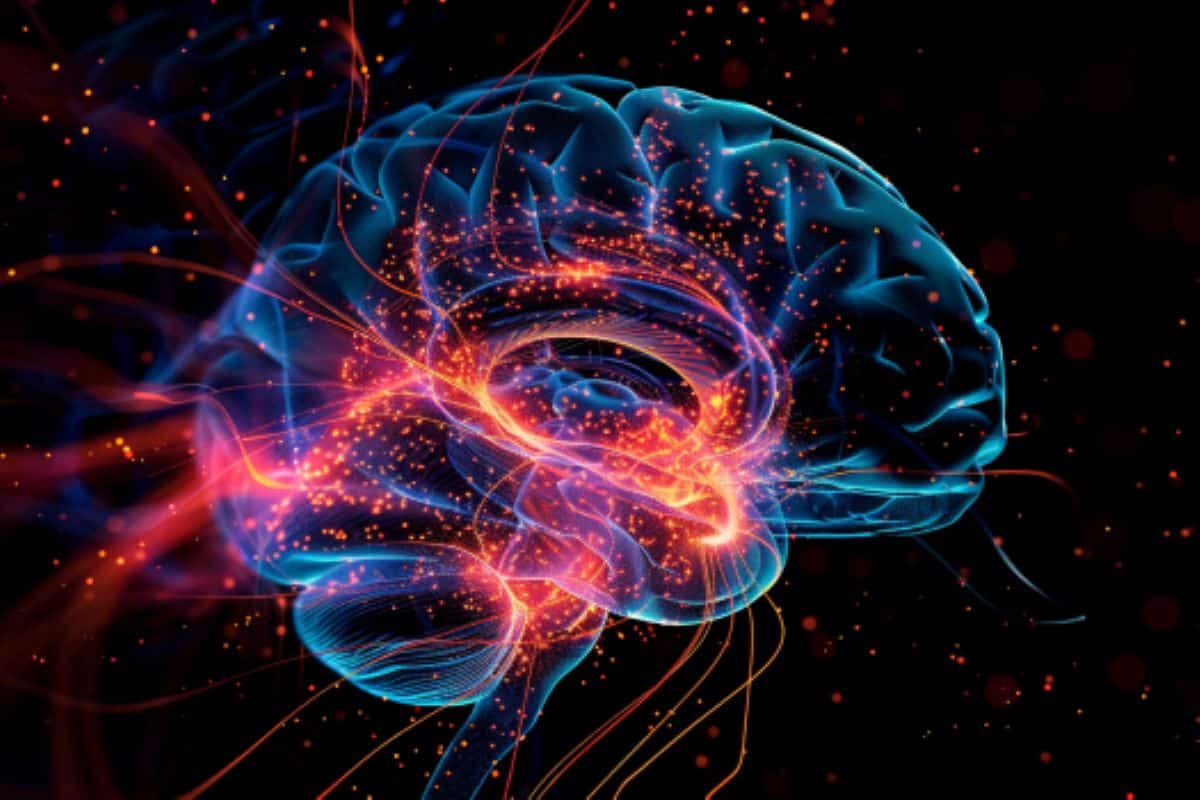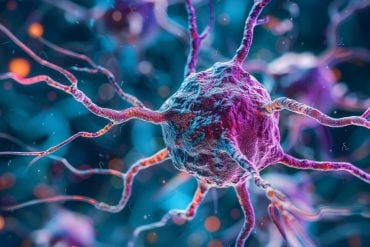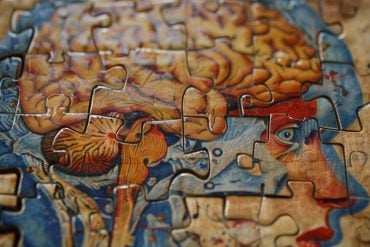Summary: A new study reveals that a balanced ratio of neural excitation (E) and inhibition (I) is crucial for brain development and cognitive performance. Researchers found that lower E/I ratios in children correlate with better memory and intelligence.
This balance is vital for preventing brain disorders and was measured using a novel AI and MRI technique. The findings could inform personalized treatments for mental health conditions.
Key Facts:
- Lower E/I ratios in children link to improved cognitive performance.
- Imbalanced E/I ratios can lead to disorders like autism, Alzheimer’s, and epilepsy.
- A new AI and MRI method allows non-invasive measurement of E/I ratios.
Source: NUS
In a world where external and internal stimuli can throw our entire body system off balance, how does our brain prevent itself from becoming overly stimulated?
The answer lies in our brain’s ability to maintain the balance of neural excitation (E) and inhibition (I), known as the E/I ratio. By regulating the E/I ratio, the brain prevents over-stimulation and under-stimulation.
The E/I ratio of children decreases with healthy development. Children with a lower E/I ratio were observed to have better performance than their peers in cognitive tests such as memory and intelligence, according to studies by researchers from the Centre for Sleep and Cognition at the Yong Loo Lin School of Medicine (NUS Medicine).

With the aim of drawing meaningful connections between E/I ratio and brain maturation, the study team, led by fourth-year PhD student Zhang Shaoshi, Associate Professor Thomas Yeo from the Centre for Sleep and Cognition at NUS Medicine, Assistant Professor Bart Larsen from the University of Minnesota and Associate Professor Theodore Satterthwaite from the University of Pennsylvania, looked at how E/I ratio changes in youths, by studying the MRI brain scans of 885 children, adolescents and young adults from the United States of America and 154 children from Singapore. E/I ratio is an aspect that is continually changing and developing throughout childhood and adolescence.
The Singaporean data cohort were obtained from GUSTO, Singapore’s largest and most comprehensive birth cohort study that seeks to help the next generation become healthier.
Described as the Yin and Yang of the brain, researchers have found that too much excitation or excessive inhibition can be harmful, leading to a higher risk of developing brain disorders, such as autism, Alzheimer’s disease and schizophrenia.
In less severe situations, someone with too much excitation might overthink in social situations, resulting in anxiety.
Indeed, a common drug for reducing anxiety symptoms is Xanax, which increases neural inhibition, thus reducing neural excitation. In more severe scenarios, over-excitation can cause an epileptic seizure.
On the opposite end of the spectrum, too much inhibition indicates an absence of brain activity, effectively putting the person in a vegetative state. Therefore, inhibition is needed to balance excitation. Overall, a balanced E/I ratio is important for a well-functioning brain.
Despite E/I’s importance for brain health, it is hard to measure its ratio in the human brain without using invasive techniques. Therefore, the team developed a technique, combining artificial intelligence and biophysical modeling to infer E/I ratios from non-invasive, non-radioactive MRI scans.
The team demonstrated the validity of their estimated E/I ratios through an experiment, during which participants ingested anti-anxiety medication (Xanax) or a placebo.
The team’s hypothesis is that once Xanax is ingested, inhibition will increase, so the overall E/I ratio decreases. To test this hypothesis, the research team scanned healthy individuals on two separate occasions.
A participant is given Xanax before one MRI session and placebo in another MRI session. For some participants, Xanax might be administered in the first session, while for others Xanax might be administered in the second session.
All parties involved in this experiment were not privy to whether an MRI session involved the placebo or the anti-anxiety drug. The team found that estimated E/I ratio markers were indeed lower after participants had ingested Xanax, compared with the placebo, and thus validating their technique.
The study team then proceeded to use MRI brain scans to study brain development in a large sample of more than 1000 children, adolescents and young adults from Singapore and the United States of America. They discover that E/I ratios decrease with healthy development.
Next, to establish the link between E/I ratios and cognitive function, the team divided participants, ranging from age 7 to 23, into high and low-performance groups based on their scores on certain cognitive tests.
They found that the high performing groups had lower E/I ratios than their peers of the same age, suggesting that cognitive abilities improve as the E/I ratio matures during development.
Beyond their study on neurodevelopment, the team is keen on applying their approach to gain mechanistic insights into various brain disorders, by studying how the E/I ratio differs between healthy participants and patients battling mental disorders. The team also aims to study how the E/I ratio changes as people age, to gain insights into neurodegenerative disorders, such as Alzheimer’s Disease.
Assoc Prof Thomas Yeo, who is also from the NUS College of Design and Engineering and Principal Investigator of this study, adds, “Our findings enhance our understanding of brain development and highlight potential avenues for understanding the emergence of psychopathology in youth.
“Hopefully, these findings will lead us to figure out which brain circuits get over-excited or over-inhibited easily, or pinpoint certain abnormal brain regions specific to an individual patient.
“This could shed more light on how medication or brain stimulation can be customised according to individuals, that would shape the course of treatment of brain disorders in the long run.”
About this neurodevelopment and cognition research news
Author: Amanda Yap
Source: NUS
Contact: Amanda Yap – NUS
Image: The image is credited to Neuroscience News
Original Research: Open access.
“In vivo whole-cortex marker of excitation-inhibition ratio indexes cortical maturation and cognitive ability in youth” by Zhang Shaoshi et al. PNAS
Abstract
In vivo whole-cortex marker of excitation-inhibition ratio indexes cortical maturation and cognitive ability in youth
A balanced excitation-inhibition ratio (E/I ratio) is critical for healthy brain function. Normative development of cortex-wide E/I ratio remains unknown. Here, we noninvasively estimate a putative marker of whole-cortex E/I ratio by fitting a large-scale biophysically plausible circuit model to resting-state functional MRI (fMRI) data.
We first confirm that our model generates realistic brain dynamics in the Human Connectome Project. Next, we show that the estimated E/I ratio marker is sensitive to the gamma-aminobutyric acid (GABA) agonist benzodiazepine alprazolam during fMRI.
Alprazolam-induced E/I changes are spatially consistent with positron emission tomography measurement of benzodiazepine receptor density. We then investigate the relationship between the E/I ratio marker and neurodevelopment.
We find that the E/I ratio marker declines heterogeneously across the cerebral cortex during youth, with the greatest reduction occurring in sensorimotor systems relative to association systems. Importantly, among children with the same chronological age, a lower E/I ratio marker (especially in the association cortex) is linked to better cognitive performance.
This result is replicated across North American (8.2 to 23.0 y old) and Asian (7.2 to 7.9 y old) cohorts, suggesting that a more mature E/I ratio indexes improved cognition during normative development.
Overall, our findings open the door to studying how disrupted E/I trajectories may lead to cognitive dysfunction in psychopathology that emerges during youth.






